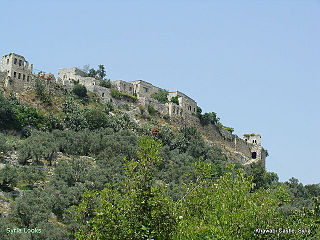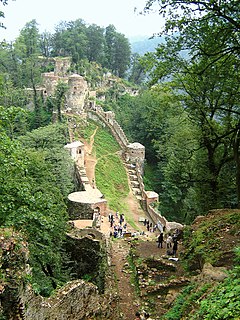 W
WList of the strongholds of the Nizari Ismaili state in Persia (Iran) and Syria.
 W
WAbu Qubays is a former medieval castle and currently an inhabited village in northwestern Syria, administratively part of the Hama Governorate, located northwest of Hama. It is situated in the al-Ghab plain, west of the Orontes River. Nearby localities include Daliyah 21 kilometers to the west, al-Laqbah to the south, Deir Shamil to the southeast, Tell Salhab to the northeast and Nahr al-Bared further northeast. According to the Syria Central Bureau of Statistics (CBS), Abu Qubays had a population of 758 in the 2004 census. Its inhabitants are predominantly Alawites.
 W
WAlamut is a ruined mountain fortress located in the Alamut region in the South Caspian province of Qazvin near the Masoudabad region in Iran, approximately 200 km (130 mi) from present-day Tehran.
 W
WThe Citadel of Furg, or Arg e Furg, is a citadel from the 18th century, located in Furg Village in Darmian County, South Khorasan, Iran. The citadel was founded by Meerza Muhammad Rafiee Darmiany I (Lama).
 W
WGahur Castle is seven kilometers from Eshtehard Road East - Iran and five kilometers south of the village Mokhtarabad Qlman among the mountains, there is a relatively high mountain which is called Mount Gahur. The castle was rebuilt in the time of Sultan Ali Mahjoub but again was destroyed after his death.
 W
WGerdkuh was a castle of the Nizari Isma'ili state located near Damghan in the region of Qumis.
 W
WGhal'eh Kuh of Ferdows is a ruined fortress on top of Kuh-e Ghal'eh, located south of Ferdows (Tun) in South Khorasan Province, Iran. The fortress was famously used by the Nizari Ismailis of the Alamut period, and was the biggest Nizari stronghold in the Quhistan region, according to the Tarikh-i Jahangushay.
 W
WGhal'eh Kuh of Hasanabad, also known as the Ghal'eh Dokhtar [of Ferdows] by the locals, is a small ruined fortress located north west of Ferdows (Tun) and near the village Hasanabad in South Khorasan Province, Iran. The fortress was used by the Nizari Ismailis of the Alamut period.
 W
WKhawabi, also spelled Qala'at al-Khawabi is a village and medieval citadel in northwestern Syria, administratively part of the Tartus Governorate, located 20 kilometers northeast of Tartus and 12 kilometers east of al-Sawda. Khawabi is situated in a hilly area, surrounded by olive groves, in the Coastal Mountain Range. Nearby localities include al-Sawda and to the west, Al-Annazah to the northwest, al-Qamsiyah to the north, Brummanet Raad to the northeast, al-Shaykh Badr to the east, Khirbet al-Faras to the south and Bimalkah to the southwest.
 W
WLambsar, Lamasar, Lambasar, Lambesar or Lomasar (لمسر) was probably the largest and the most fortified of the Ismaili castles. The fortress is located in the central Alburz mountains, south of the Caspian Sea, about 120 km from present-day Tehran, Iran. Lambsar is to the northeast of Razmian village.
 W
WMasyaf Castle is a medieval structure in the town of Masyaf in Hama Governorate, Syria, situated in the Orontes Valley, approximately 40 kilometers to the west of Hama. It served to protect the trade routes to cities further inland such as Banyas. The castle itself stands on a platform about 20 meters above the surrounding plain. The citadel became famous as the stronghold from which Rashid ad-Din Sinan, known as the Old Man of the Mountain, ruled from 1166-1193. He was a leader of the Syrian branch of the Nizari Isma'ili sect, also known as the Assassins, and a figure in the history of the Crusades.
 W
WThe Nimrod Fortress or Nimrod Castle is a medieval Ayyubid castle situated on the southern slopes of Mount Hermon, on a ridge rising about 800 m above sea level. It overlooks the Golan Heights and was built with the purpose of guarding a major access route to Damascus against armies coming from the west.
 W
WRudkhan Castle ; also Roodkhan Castle, is a brick and stone medieval fortress in Iran that was built by the Gilaks to defend against the Arab invaders during the Arab/Islamic invasion of Sassanian Iran. With the fall of the Sassanid Empire, this area became a defensive position against the Arabs in the then-newly established Tabarestan.
 W
WAl-Rusafa is a Syrian village located in the Masyaf Subdistrict in Masyaf District, located west of Hama and about 10 kilometers southwest of Masyaf. According to the Syria Central Bureau of Statistics (CBS), al-Rusafa had a population of 1,608 in the 2004 census. Its inhabitants are predominantly Alawites. It is the site of a former Ismaili fortress.
 W
WSaru Castles are two related fortifications located at 10 km in north east of the city of Semnan, Iran, on mountains of south and north of a valley called Kalāteh Sārū or Mazra'eh-ye Sārū. The northern castle, the Lesser Saru, is mostly in ruins. The southern castle, the Greater Saru, or simply the Saru Castle, is the main one and is relatively intact. It is 100 m higher than the Lesser Saru. The Greater Saru has triple defensive outer walls and an unusual double-bend main entrance way, and features a sophisticated water catchment area. The Lesser Saru was used to defend the Kalateh Saru natural springs from which water was pumped to the main castle.
 W
WDizkuh or Shahdiz (شاهدز) was a fortress near Isfahan, Iran, notably held by the Nizari Ismailis. It was captured and destroyed in Seljuk sultan Muhammad Tapar's anti-Nizari campaign. Its conspicuous, picturesque ruins lie about 8 km south of Isfahan on a subpeak of Mount Soffeh.